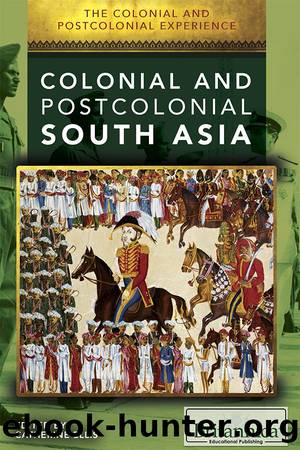The Colonial and Postcolonial Experience in South Asia by Catherine Ellis

Author:Catherine Ellis
Language: eng
Format: epub
Publisher: Britannica Educational Publishing
Published: 2016-12-16T00:00:00+00:00
ANTI-BRITISH ACTIVITY
Anti-British terrorist activity started soon after the war began, sparked by the return to India of hundreds of embittered Sikhs who had sought to emigrate from their Punjab homes to Canada but who were denied permission to disembark in that country because of their colour. As British subjects, the Sikhs had assumed they would gain entry to underpopulated Canada, but, after wretched months aboard an old Japanese freighter (the Komagata Maru) in cramped and unsanitary conditions with inadequate food supplies, they returned to India as confirmed revolutionaries. Leaders of the Ghadr (âRevolutionâ) party, which had been started by Punjabi Sikhs in 1913, journeyed abroad in search of arms and money to support their revolution, and Lala Har Dayal, the partyâs foremost leader, went to Berlin to solicit aid from the Central Powers.
Muslim disaffection also grew and acquired revolutionary dimensions as the Mesopotamian campaign dragged on. Many Indian Muslims appealed to Afghanistan for aid and urged the emir to start a holy war against the British and in defense of the caliphate. After the war the KhilÄfat movement, an offspring of growing pan-Islamic consciousness in India, was started by two fiery orator-journalists, the brothers Shaukat and Muhammad Ali. It lured thousands of Muslim peasants to abandon their village homes and trudge over frozen high passes in a disastrous hijrah (âflightâ) from India to Afghanistan. In Bengal, terrorist bombings continued to harass officials, despite numerous âpreventive detentionâ arrests made by Indian Criminal Intelligence Division police under the tough martial-law edicts promulgated at the warâs inception.
The deaths of Gokhale and of the Bombay political leader Sir Pherozeshah Mehta in 1915 removed the most powerful moderate leadership from the Congress Party and cleared the way for Tilakâs return to power in that organization after its reunification in 1916 at Lucknow. That historic session in December 1916 brought even greater unity to Indiaâs nationalist forces, as the Congress and the Muslim League agreed to a pact outlining their joint program of immediate national demands. The Lucknow Pact called first of all for the creation of expanded provincial legislative councils, four-fifths of whose members should be elected directly by the people on as broad a franchise as possible. The leagueâs readiness to unite with the Congress Party was attributed to the pactâs stipulation that Muslims should receive a far higher proportion of separate electorate seats in all legislative councils than they had enjoyed under the act of 1909. Thanks to such generous concessions of political power by the Congress, Muslim leaders, including Mohammad Ali Jinnah (1876â1949), agreed to set aside doctrinal differences and work with the Congress toward the attainment of national freedom from British rule. That rapprochement between the Congress Party and the Muslim League was short-lived, however. By 1917 communal tensions and disagreements once again dominated Indiaâs faction-ridden political scene. Tilak and Annie Besant each campaigned for different home-rule leagues, while Muslims worried more about pan-Islamic problems than all-India questions of unity.
Download
This site does not store any files on its server. We only index and link to content provided by other sites. Please contact the content providers to delete copyright contents if any and email us, we'll remove relevant links or contents immediately.
Harry Potter: A Journey Through a History of Magic by British Library(368)
The Science of Philip Pullman's His Dark Materials by Mary Gribbin(343)
The Basics of Organic Chemistry by Clowes Martin;(342)
Harry Potter and the Sorcerer's Stone: SparkNotes Literature Guide by SparkNotes(305)
Flowers in the Gutter by K. R. Gaddy(272)
Braiding Sweetgrass for Young Adults by Robin Wall Kimmerer(266)
Super Simple Chemistry by D.K. Publishing(262)
Summary of the Selfish Gene by Readtrepreneur Publishing(259)
Exam Success in Geography for IGCSE & O Level by Unknown(258)
JavaScript Coding for Teens: A Beginner's Guide to Developing Websites and Games by Yueh Andrew(251)
Dark days in Salem: the witchcraft trials by Deborah Kent(244)
The Python Audio Cookbook;Recipes for Audio Scripting with Python by Alexandros Drymonitis(240)
Analysis and Linear Algebra for Finance: Part II by Bookboon.com(236)
Key Immigration Laws by Kathryn Ohnaka(229)
Cracking the AP Economics Macro & Micro Exams, 2017 Edition by Princeton Review(225)
Solutions for a Cleaner, Greener Planet: Environmental Chemistry by Marc Zimmer(216)
The Science of Fashion by Julie Danneberg;(212)
Reverse Engineering For Everyone! by mytechnotalent(203)
Cracking the AP Psychology Exam, 2017 Edition by Princeton Review(199)
